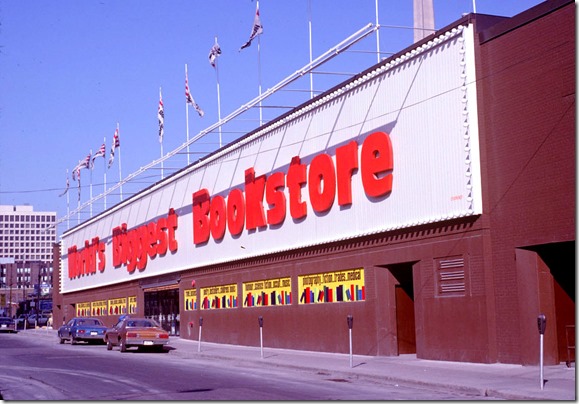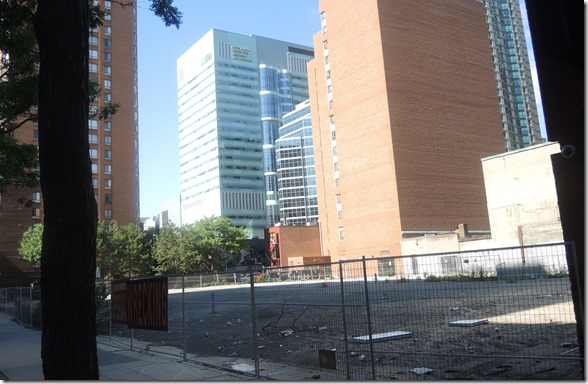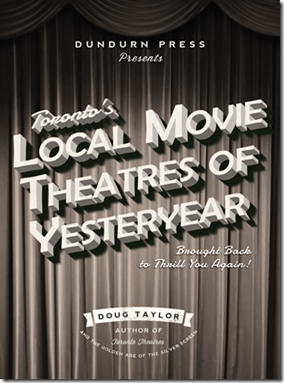World’s Biggest Book Store on Edward Street on April 16, 1981. Photo from the Toronto Archives, F1526, Fl001, Item 2.
I attended high school in the 1950s, when the Ontario Government did not pay for high school texts. On the Tuesday following Labour Day, my friends and I attended Vaughan Road Collegiate to discover which homeroom form we had been assigned, and to pick up a list of the texts that were required for the year’s studies. Following this, we visited the Coles Book at 720 Yonge Street. Coles possessed the largest supply of secondary school texts in the city, so it was possible to purchase all the books we needed in a single visit. The other advantage, was that Coles purchased used texts and resold them at a discount price. This often saved us money.
In 1953, I had a summer job at the Imperial Bank near Yonge and Bloor Streets, next door to the Pilot Tavern. On my lunch hour, I often strolled south on Yonge to the Coles store at 720 Yonge Street. I soon discovered that in the section displaying art books, there were photographs of naked figures, which art students employed for drawing the human form. Being a teenager, I was far to embarrassed to ever buy one of the books, but they were great to peruse for a cheap thrill. I always gazed around to be certain that no one was aware of the books I was looking at.
Coles was a vital part of Toronto during the days before e-books. In 1935, Carl E. Cole and his brother Jack, opened a second-hand bookstore near Bloor Street and named it Cole Books. In 1937, they purchased the Robert Barron property at 720 Yonge Street and opened a larger store. In 1948, they began publishing Coles Notes, which provided detailed and simplified notes about various topics that related to the secondary school curriculum. Student who had failed to keep proper notes during classes often bought them when exam time arrived. This is why they were often referred to as “cheat books.” Eventually, Coles Notes covered about 120 titles. Due to increased book sales, in 1952, they extended the store into the shop next door, and eventually opened other stores across Canada.
In 1974, the Barron Building that housed the store, was declared a Heritage building, as it had been built in 1889.
In 1980, Coles opened a 67,000 square-foot book store at 20 Edward Street, a short distance west of Yonge Street. They named it, “The World’s Biggest Book Store,” and though its name was not truly accurate, it was one of Canada’s first book superstores. It had previously been the site of the Olympic Bowling Alley, which was architecturally an enormous box-like structure. The store contained two storeys, was brightly lit, and had garish yellow walls. Despite these features, it contained small intimate areas, where customers could examine books before deciding whether or not to purchase them. It’s a pity that the store at 720 Yonge Street did not possess these spaces when I was a teenager ogling nudie books.
Because the store remained open late into the evening hours, people sometimes browsed for an hour or more. The store was located not far from A&A Records and Sam’s Records, which also attracted late-night customers. Thus, the World’s Biggest Book Store was an integral part of the night scene on Yonge Street. I personally liked the store as I was able to find books by authors that other stores did not stock. I also purchased many books that were deeply discounted. The store had large bins with books that were half-price or more, and clearance sales were frequent. The store eventually carried gift cards, souvenirs, stationery, and even toys.
In 1995, Coles Books and W. H. Smith books merged to form a new company named Chapters. The following year, Chapters merged with Indigo Books to create Chapters/Indigo. However, with the introduction of the internet and the rise of e-books, the store on Edward Street was too large to remain profitable. It is a wonder that it lasted as long as it did. The building was sold to a real estate developer in February 2013, and the store was closed on March 30, 2013. The building was demolished to create a row of restaurants.
Personally, I felt that the city was diminished when The World’s Biggest Book Store closed. I spent many happy hours wandering its aisles. I now have a large selection on books on Toronto, many of which were bought in the store. However, after reading some of the comments posted online about the store, I realize that some people were pleased to see it close. Pity!
Sources: www.toronto.ca, urbantoronto.ca
The camera is pointed west on Edward Street. Photo from the Star.com
Gazing west on Edward Street at the store. Photo from the CBC.
Looking west on Edward Street at night, photo from blogTo – 2014225
Interior of the store, photo from Metro News (the Star) dc_062012_04881e.
The store during demolition, photo from Commercial Daily News.com, 002_RBI
The empty lot where the World’s Biggest Book Store was located. Photo taken on September 19, 2016.
The Robert Barron Building at 720 Yonge Street, which was once a Coles Book Store, photo from Urban Toronto.ca. In 1995, it became a Shoppers Drug Mart. The building is presently being restored as it is a heritage property.
To view the Home Page for this blog: https://tayloronhistory.com/
For more information about the topics explored on this blog:
https://tayloronhistory.com/2016/03/02/tayloronhistory-comcheck-it-out/
The publication entitled, “Toronto’s Theatres and the Golden Age of the Silver Screen,” was written by the author of this blog. It explores 50 of Toronto’s old theatres and contains over 80 archival photographs of the facades, marquees and interiors of the theatres. It relates anecdotes and stories by the author and others who experienced these grand old movie houses.
To place an order for this book:
Book also available in Chapter/Indigo, the Bell Lightbox Book Shop, and by phoning University of Toronto Press, Distribution: 416-667-7791 (ISBN 978.1.62619.450.2)
Another book, published by Dundurn Press, contains 80 of Toronto’s former movie theatres. It is entitled, “Toronto’s Movie Theatres of Yesteryear—Brought Back to Thrill You Again.” It contains over 125 archival photographs and relates interesting anecdotes about these grand old theatres and their fascinating histories.
Link to order this book: https://www.dundurn.com/books/Torontos-Local-Movie-Theatres-Yesteryear
Another publication, “Toronto Then and Now,” published by Pavilion Press (London, England) explores 75 of the city’s heritage sites. This book will be released in June 2016. For further information follow the link to Amazon.com here or contact the publisher directly by the link shown below:
http://www.ipgbook.com/toronto–then-and-now—products-9781910904077.php?page_id=21.

![The Star.com bookstoreturn.jpg.size.custom.crop.1086x753[1] The Star.com bookstoreturn.jpg.size.custom.crop.1086x753[1]](https://tayloronhistory.com/wp-content/uploads/2016/07/the-star-com-bookstoreturn-size_-custom-crop_-1086x7531_thumb.jpg)
![CBC. worlds-biggest-bookstore[1] CBC. worlds-biggest-bookstore[1]](https://tayloronhistory.com/wp-content/uploads/2016/07/cbc-worlds-biggest-bookstore1_thumb.jpg)
![Blogto 2014225-worlds-biggest-bookstore[1] Blogto 2014225-worlds-biggest-bookstore[1]](https://tayloronhistory.com/wp-content/uploads/2016/07/blogto-2014225-worlds-biggest-bookstore1_thumb.jpg)
![Metro News dc_062012_0481e.jpg.size.xxlarge.promo[1] Metro News dc_062012_0481e.jpg.size.xxlarge.promo[1]](https://tayloronhistory.com/wp-content/uploads/2016/07/metro-news-dc_062012_0481e-size_-xxlarge-promo1_thumb.jpg)
![Daily Commercial News.com 002_RBI-image-1007095[1] Daily Commercial News.com 002_RBI-image-1007095[1]](https://tayloronhistory.com/wp-content/uploads/2016/07/daily-commercial-news-com-002_rbi-image-10070951_thumb.jpg)

![Urban Toronto.ca 21238-72974[1] Urban Toronto.ca 21238-72974[1]](https://tayloronhistory.com/wp-content/uploads/2016/07/urban-toronto-ca-21238-729741_thumb.jpg)
![cid_E474E4F9-11FC-42C9-AAAD-1B66D852[2] cid_E474E4F9-11FC-42C9-AAAD-1B66D852[2]](https://tayloronhistory.com/wp-content/uploads/2016/07/cid_e474e4f9-11fc-42c9-aaad-1b66d8522_thumb.jpg)




Hey! A fellow alumnae of VCRI– go red, blue and gold! I too ended up in a bank, TD at Avenue Rd. and Eglinton but not till 1964. I was at Vaughan from 1960-1963.
The store was actually closed in 2014.
https://www.thestar.com/business/2014/02/11/worlds_biggest_bookstore_to_be_replaced_by_row_of_restaurants.html
I loved this store. As a student with an inquiring mind I found many books by accident that were supplemental to our school curriculum. You could not walk into that store and not walk out without a book, or books under your arm. I would buy books for future reading. The staff were very helpful looking up book titles or authors and they could steer you to the right book section. The WORLD’S BIGGEST BOOKSTORES should be a part of every true blue Torontonian. Visiting Yonge Street on the weekend was common with my school mates. On Monday we would convene to find out who managed to score an old book out of print but was being reprinted by another printing house. Those were the educational glory days of Toronto’s average schmo who could proudly say on Monday “I was at THE WORLD’S BIGGEST BOOKSTORE on the weekend and be the envy of his classmates. If it was known that someone was going to the bookstore he may be toting a list of books to look up or buy.(Cash up front). The lost art of browsing and discovering has been taken away from the budding “Young Sheldons”. We can only hope that in the future an equivalent replacement can be erected. It’s been fifty years since I was in that bookstore but it is like losing an integral family member.This could be a great project for the Toronto Council.